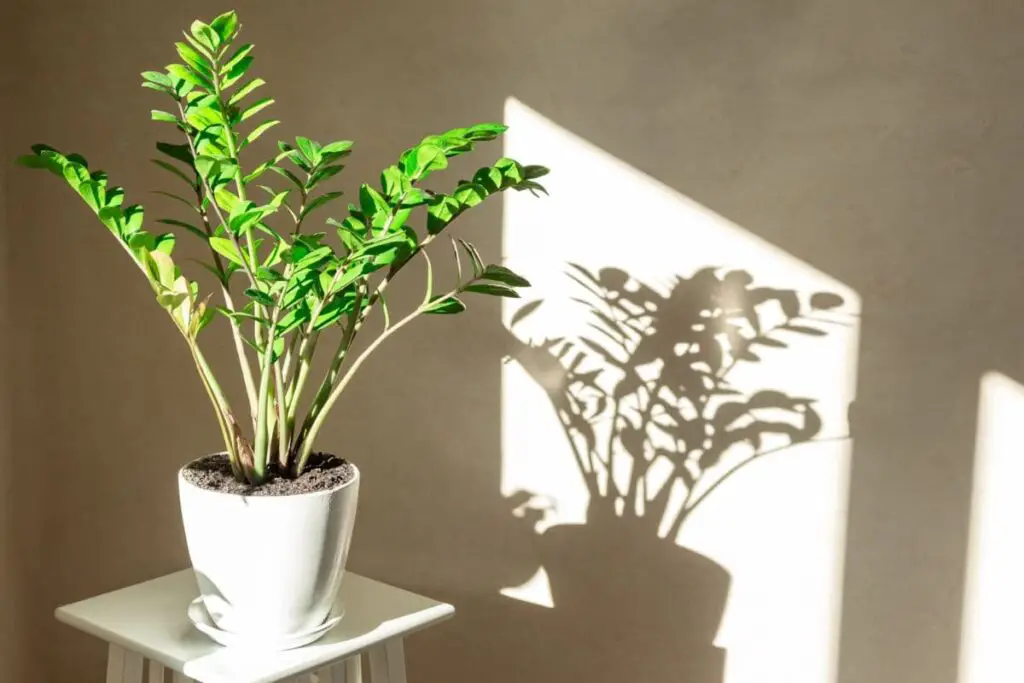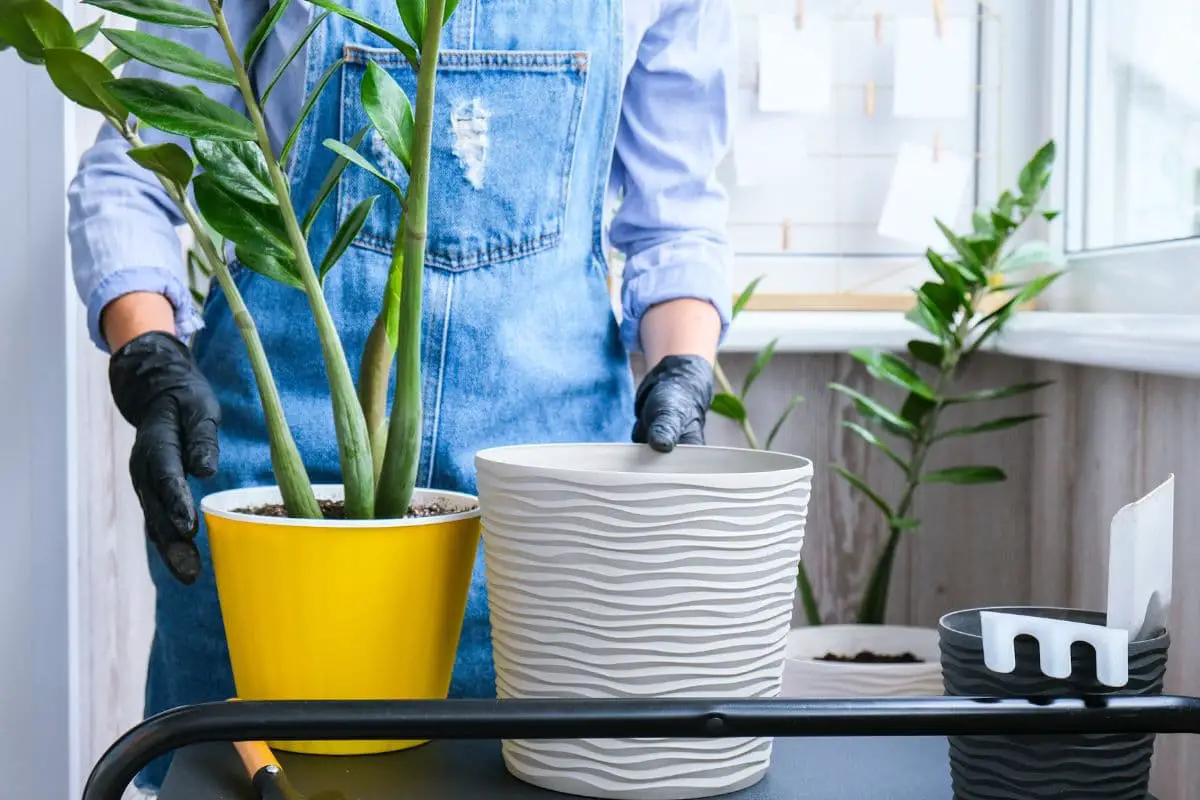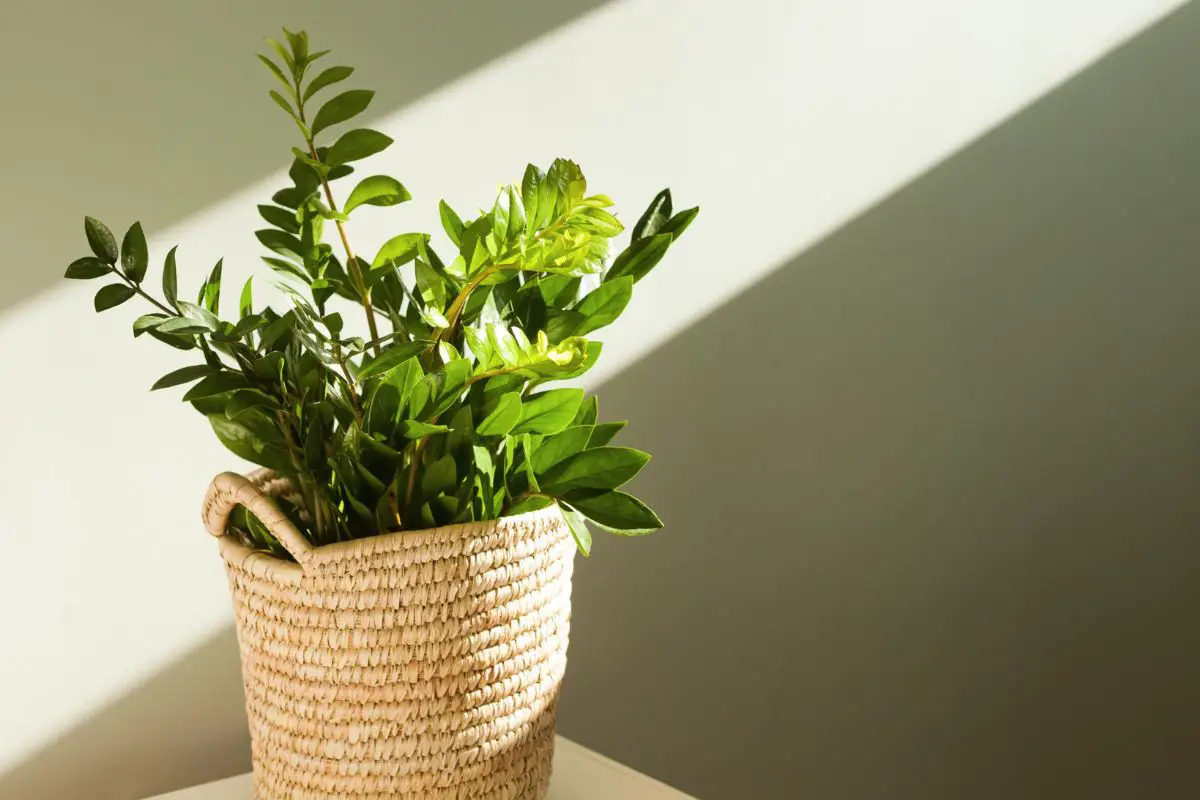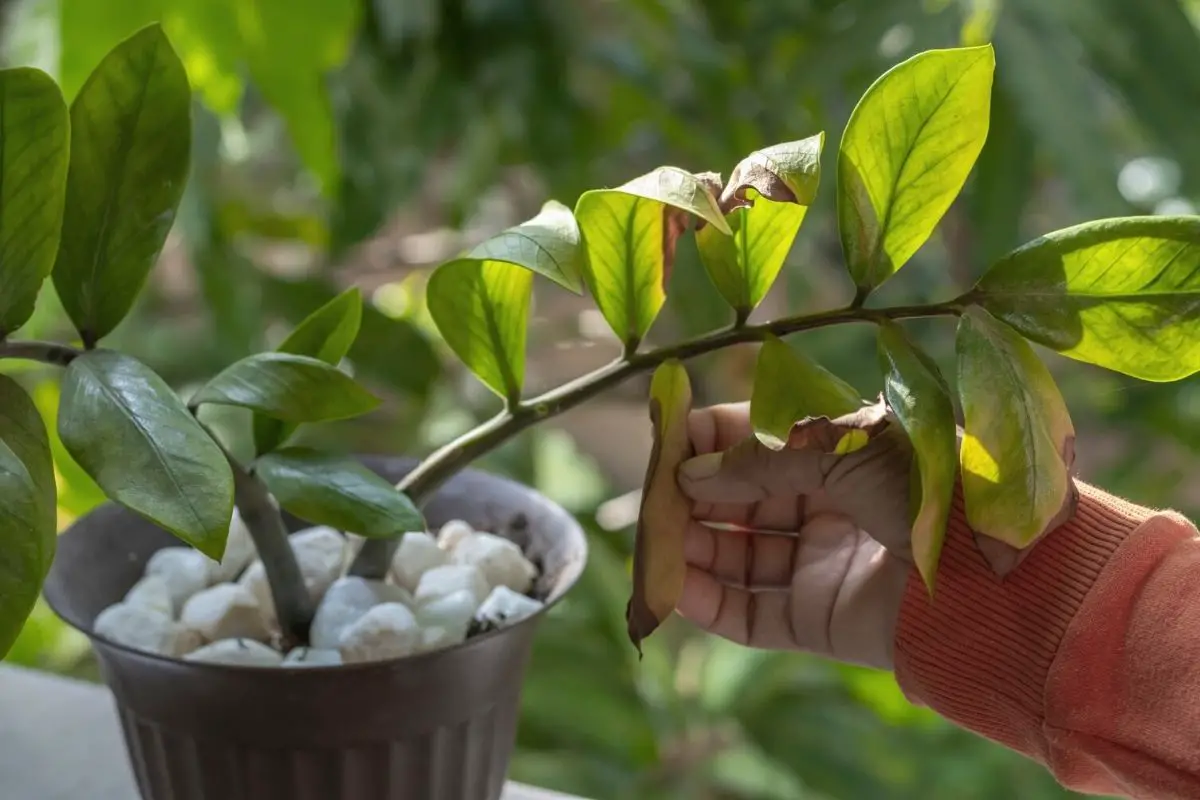ZZ plants have flat, glossy, green leaves that look almost synthetic. The waxy coating on the leaves helps preserve them for about 2-6 months before they gradually turn yellow due to aging. However, the leaves can prematurely curl or wrinkle if the plant is stressed.
Here’s a list of the common causes of leaf curling in ZZ plants:
- Underwatering
- Too much sunlight
- Overwatering
- Heat stress
- Low humidity
- Pest infestation
- Nutrient deficiency
- Being rootbound
Leaf curling is a common issue in ZZ plants, which can range from an early sign of stress to a late-stage health issue that needs immediate treatment. This article will discuss the causes of leaf curling and their corresponding fixes.

ZZ Plants: An Overview
The ZZ plant (Zamioculcas zamiifolia) is famous for its tolerance to low light conditions and infrequent watering. These traits can be attributed to its native habitat in tropical East or South Africa, with sporadic rains, shady forests, and loose soil.
It has developed fleshy roots, rhizomes, and stems to store extra moisture that can last several weeks to months during periods of drought.
Although the plant may survive extended dry periods, temperature fluctuations and weather changes can cause the leaves to curl or wrinkle.
Indoor ZZ plants may also have curled leaves when constantly exposed to poor environmental conditions and neglect. Pay attention to the leaves’ appearance to diagnose and fix the problem before the damage becomes irreversible.
Symptoms of Curling Leaves
A healthy ZZ plant leaf is flat and glossy with a dark emerald hue. Although flat, the waxy covering makes the leaves feel firm.
Conversely, an unhealthy leaf may show the following curling patterns:
- A paler hue and curling on the edges
- Yellow or brown thin leaves that have lost their waxy shine and curling from the tips and edges
- Dents and curls in multiple spots
These symptoms may occur in the early stages of stress or after severe damage, depending on the underlying cause.
Common Causes (& Fixes)
ZZ plant leaves may curl due to the following reasons:
Underwatering
Frequent underwatering and dehydration are the primary causes of leaf curling or wrinkling in ZZ plants. Without enough water, they’ll use up the moisture stored in the rhizomes or stems until they can no longer support the leaves.
The soil might also become hydrophobic if frequently allowed to become bone-dry. The water will rapidly drain through the cracks or along the edges of the pot and exit through the drainage holes. Even if you water the plant, the roots and rhizomes can’t access the moisture.
The thirsty leaves will then show the following symptoms in progression:
- Droop or wilt
- Turn pale and paper-thin, making them easier to curl up or wrinkle
- Turn yellow and brown from the edges before curling up
Here are some tips to improve your plant’s appearance:
- Wear gloves and pinch the discolored and curled leaves. On the other hand, green, curling leaves can stay on the plant because they will regain their shape when properly rehydrated.
- If the entire stem has wilted and discolored leaves, use sterile shears to cut it down to an inch (2.5 cm) above the soil.
- Bottom-water your plant for 10-30 minutes to rehydrate the soil. If the soil is severely hydrophobic, add a wetting agent to the water or repot your plant in a fresh potting mix rich in organic matter.
- Water your plant as soon as the top half of the potting mix is dry. During the cold season, you can wait until the upper ⅔ is dry.
- Adjust your watering schedule accordingly, especially if your area experiences significant seasonal light intensity and temperature fluctuations.
Too Much Sunlight
ZZ plants thrive in dappled sunlight in their native habitat.
Intense, direct sunlight can turn the leaves yellow or brown and crisp and cause them to curl. Even a few hours of direct sunlight daily can dry out the soil more quickly and worsen the effects of underwatering.
Unfortunately, leaves scorched and curled due to too much sunlight cannot return to their original appearance and will need to be pruned.
You must also make the following adjustments in your care routine to protect your plant from too much light or leaf burn:
- Move the plant 1-2 feet (0.3-0.6 m) away from a bright window or hang a light curtain to filter the light.
- Rotate the pot by 90-180° weekly if your plant is in bright light or every time you water if it’s in low light.
- Adjust the watering frequency depending on the light intensity and duration of exposure. Plants in brighter light need more frequent watering.

Overwatering
In the early stages of overwatering, ZZ leaves may appear firm and drip some water (guttation). Some leaves may also have wet, mushy spots.
As the issue progresses to root rot, the plant can no longer send moisture to the shoots. The leaves will then show signs of dehydration, including yellowing leaves, browning, or curling.
In the early stages of rot, you may still propagate your plant by saving the remaining healthy leaves. On the other hand, leaves with signs of curling are no longer good candidates for propagation because they’re unlikely to develop roots or rhizomes when planted in fresh soil.
Leaf curling due to overwatering and root rot clearly indicates severe and irreversible damage because the roots are decayed.
Since overwatering is one of the most probable causes of ZZ plant decay, you must avoid this problem with the following watering tips:
- Use loose, well-draining soil, such as a high-quality succulent or compost-perlite mix.
- Wait until the soil is dry halfway through before watering your plant.
- When bottom-watering, don’t let the soil soak for more than 30 minutes.
- Let the excess moisture drip from the drainage holes before placing the pot over the saucer.
- Discard the water that accumulates on the saucer.
Heat Stress
ZZ plants like moderate temperatures around 65-85 °F (18-29 °C). Although they can tolerate temperatures up to 90 °F (32 °C) for short periods, constantly high temperatures can cause heat stress.
The leaves tend to curl when placed next to heating vents or hot, sunny windows. Even grow lights can cause heat stress if placed too close to the foliage. The damage is typically more severe if the plant is underwatered and can lead to brown and crisp leaves.
Curling due to high temperatures is also irreversible on affected foliage, but you can improve the appearance of the new growth by keeping the following tips in mind:
- Prune the damaged foliage.
- Keep your plant away from sunny and bright windows, heating vents, or appliances that generate hot air, such as refrigerators.
- Water your plant regularly. Don’t wait until the soil is dry all the way through.
- Maintain the temperature around 75 °F (24 °C). Increase the watering frequency accordingly if indoor temperatures rise in the summer.
- Maintain a 6-12-inch (15-30 cm) distance between the foliage and grow lights, if used. The higher the wattage of the grow light, the farther it should be from your plant. Tip: Use an adjustable stand so you can adjust the light as the plant grows taller.
Low Humidity
As tropical natives, ZZ plants can tolerate a wide range of humidity levels.
However, constantly low humidity can exacerbate plant dehydration. If the air surrounding the leaves is dry, they will transpire more. As they lose moisture, they become flimsy and more prone to curling.
You can fix a mildly dehydrated ZZ plant with the following tips:
- Water your plant deeply to rehydrate the soil properly.
- Maintain moderate humidity (40-50%). You can use a humidifier or place the pot over a pebbled tray with water.
- Improve the light and temperature conditions around your ZZ plant based on the tips above.
Pest Infestation
ZZ plants are naturally resistant to most pests due to the calcium oxalate crystals in their sap. Nevertheless, common houseplant pests like aphids, mealybugs, and scale mites might feed on your stressed plant if your indoor garden offers limited food sources.
The severity of the pest damage can vary depending on the plant’s age and size:
- A mature ZZ plant can easily overcome a minor infestation with little to no symptoms. Pest attacks may leave tiny holes with yellow margins on existing leaves, but they are unlikely to kill the plant.
- Young plants may have stunted growth due to an attack since they don’t have efficient food and moisture storage and management yet.
For instance, I noticed a mealybug infestation on my newly rooted and transplanted ZZ cuttings. The new leaves had dents and curls at random spots and didn’t grow to full size. I had to dispose of the young plant and start propagating all over again.
You must deal with pest infestations in your indoor garden to prevent the insects from spreading among nearby and vulnerable plants.
Here’s how:
- Identify and isolate the plant with severe infestation.
- Remove the pests using cotton swabs dipped in rubbing alcohol and drop them in soapy water. Do the same for the remaining plants in your indoor garden.
- Spray your plants generously with neem oil solution once a week until there are no more pests.
- Inspect your plants’ leaf undersides and stems weekly to catch pests as soon as they appear.
- Continue spraying your plants with neem oil solution once every 2 weeks as a preventive measure.
Nutrient Deficiency
ZZ plants are slow-growers, so they don’t require much fertilizer. After repotting, they can get by with the nutrients from a high-quality compost for one year. They might need supplemental fertilizers the following spring.
A deficiency in the following nutrients can cause the leaves to grow distorted or curl:
- Phosphorus
- Potassium
- Calcium
- Magnesium
These nutrients are crucial for plant development and nitrogen transport. Although the soil mix may contain sufficient nitrogen, the nutrient might be lost to the atmosphere if not properly delivered to the shoots to promote new growth with a stable structural framework.
Prune damaged leaves because they won’t recover. To encourage your plant to grow healthy new leaves, you must fertilize your plant during the growing season (spring until summer.
Here’s how:
- Feed your plant a slow-release 10-10-10 fertilizer with micronutrients like calcium and magnesium. Phosphorus and potassium are both macronutrients that you can feed your plant using a balanced NPK fertilizer.
- Apply the fertilizer in early or mid-spring and observe the appearance of the new leaves.
- Water your plant regularly to prevent fertilizer burn, which can cause dehydration and leaf scorch.
- Reapply the fertilizer in early summer if the new growth still has distorted or curled leaves.
Being Rootbound
ZZ plants like being snug in their pots because they grow slowly. Still, a severely rootbound plant may exhibit stunted growth and curled leaves because of the following issues:
- Overgrown roots and rhizomes can displace the potting soil. If there isn’t much soil to hold onto moisture, the plant eventually becomes dehydrated and the leaves curl.
- The overcrowded leaves can provide cover for ZZ plant pests. New leaf growth from smaller rhizomes may curl from severe pest infestations.
Repot your plant every 2-3 years or divide it if it’s more than a foot (30 cm) wide at the base. This will give your plant enough space to grow and fresh nutrients from the new potting mix. In addition, you’ll have more compact plants that are easier to work with.
Final Thoughts
Curling leaves from mild dehydration can often be reversed after properly watering your ZZ plant, moving it out of direct sunlight, and maintaining moderate temperatures and humidity. On the other hand, curled leaves with dents, discoloration, or distortion cannot recover and must be pruned.
ZZ plants grow slowly, especially outside the growing season, so restoring them to their best shape can be tedious and long. Follow the tips above to improve your care routine and encourage your plant to grow healthy new leaves.
Let us know about your experience with curled or wrinkled ZZ leaves and share insights on how you overcame the problem. You can also reach out for any questions regarding general ZZ plant care.







